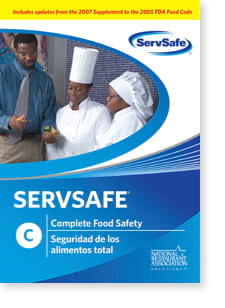The Ultimate Guide to Becoming a Certified ServSafe Food Handler in Your State
The Ultimate Guide to Becoming a Certified ServSafe Food Handler in Your State
Blog Article
Comprehensive Food Handlers Training for Health and Safety
In today's rapidly advancing food service landscape, comprehensive food handlers training has actually arised as an essential element for guaranteeing hygiene and safety and security. By instilling essential methods connected to hand health, food storage, and sanitation, this training not just minimizes the risk of foodborne health problems but additionally strengthens compliance with regulative standards. The ramifications of such training expand beyond simple compliance; they discuss public health and customer count on. Yet, the performance of these training programs can vary significantly. What factors genuinely identify their success in fostering a culture of safety and security?
Relevance of Food Safety And Security Training

Furthermore, food safety and security training aids to make sure that workers recognize current regulations and standards, which are vital for keeping functional licenses and avoiding costly penalties. Regular training sessions also offer as a platform for strengthening ideal methods, thus minimizing the chance of human mistake, which usually acts as a leading root cause of food contamination.
Furthermore, purchasing food safety and security training can enhance an establishment's credibility, as consumers significantly prioritize eating experiences that mirror high security criteria. Such positive actions not only safeguard consumers but additionally contribute to the long-term success of food companies. In summary, thorough food safety training is an essential component of food solution procedures, straight affecting both public health and wellness and service sustainability.
Trick Concepts of Hygiene
Keeping high standards of hygiene is necessary in any food managing setting to protect against contamination and make certain the safety and security of consumers. The key concepts of health include several crucial methods that food trainers must continually use.
First, hand hygiene is extremely important; food handlers must wash their hands thoroughly with soap and water prior to and after managing food, along with after utilizing the toilet or touching any type of potentially contaminated surface areas. Tools and surfaces have to be routinely cleaned up and disinfected to eliminate virus. This consists of tools, cutting boards, and countertops, which ought to be preserved in a clean problem.


Proper food storage is likewise important; raw foods must be stored independently from prepared or ready-to-eat items to stay clear of cross-contamination. servsafe certifications. Additionally, preserving proper temperature level controls is crucial; perishable products should be maintained at safe temperature levels to prevent microbial growth
Last but not least, personal hygiene can not be forgotten. Food trainers must use tidy clothing, use hair restrictions, and prevent working when ill. By sticking to these essential principles of hygiene, food handlers can significantly minimize the threat of foodborne illnesses and advertise a much safer eating experience for all customers.
Common Foodborne Diseases
Although lots of foodborne diseases can be prevented with appropriate health and safe food dealing with techniques, they continue to be a substantial public health concern. Foodborne microorganisms can result in a variety of health problems, ranging from mild stomach distress to severe issues and even death.
Typical foodborne illnesses include salmonellosis, triggered by Salmonella bacteria, frequently linked to undercooked chicken and eggs. One more common health problem is listeriosis, associated with raw dairy products and ready-to-eat meats, which can Our site be specifically hazardous for expecting women and immunocompromised people. Norovirus, often acquired from infected food or surface areas, is understood for its rapid spread and capacity to trigger break outs in public settings.
Escherichia coli (E. coli) infection, notably related to undercooked ground beef and contaminated fruit and vegetables, can result in extreme stomach pains and kidney failing in some situations. Furthermore, Clostridium perfringens, typically located in big quantities of food that are poorly stored, can create gastrointestinal disorder with symptoms showing up shortly after consumption.
Recognizing these illnesses is vital for food trainers, as recognition can significantly lower the danger of contamination and safeguard public health and wellness. Proper education and training are important elements in combating foodborne conditions.
Best Practices for Food Handling
Effective food managing practices are vital in preventing the spread of foodborne health problems. First of all, correct hand hygiene is important; food handlers have to clean their hands extensively with soap and water before and after taking care of food, particularly raw meat or poultry - servsafe certifications. This basic activity dramatically decreases the risk of cross-contamination
Second of all, preserving proper food storage temperature levels is important. Consistently sterilize kitchen counters, cutting boards, and tools, particularly after preparing raw foods. Use different cutting boards for raw and ready-to-eat foods to further lessen contamination risks.
Additionally, when preparing food, it is important to follow the concept of "initial in, first out" (FIFO) to take care of inventory successfully and reduce spoilage. Finally, constantly adhere and review to foodstuff tags for risk-free cooking temperatures and dealing with instructions. By carrying out these best practices, food trainers can substantially improve food safety and security and protect public health and wellness.
Implementing a Safety And Security Culture
Developing a security culture within a food handling atmosphere is crucial for promoting a dedication to food safety and security among all personnel. This culture highlights the significance of food safety as a common obligation, motivating staff members to prioritize hygiene methods continually.
To execute a security society, companies must begin by giving extensive training that deals with food handling methods, possible risks, and the importance of personal health. Educating sessions must be interactive and web tailored to the particular functions of staff participants, making sure significance and engagement.
Moreover, management plays a crucial duty in developing this culture. Monitoring needs to model secure methods and interact the value of food security on a regular basis. Recognizing and rewarding employees that maintain safety and security criteria can navigate to this website additionally enhance these actions.
Additionally, open communication networks have to be established, allowing staff to report security worries without worry of repercussion. Normal safety and security audits and responses sessions can help determine locations for enhancement and enhance liability.
Inevitably, growing a safety and security culture not just enhances compliance with food safety laws however additionally safeguards public health, cultivates employee morale, and adds to the overall success of the food taking care of facility.
Conclusion
Finally, thorough food trainers training plays a pivotal duty in advertising hygiene and security within food service facilities. By outfitting workers with necessary knowledge regarding food safety and security principles, common foodborne diseases, and best methods for taking care of food, such training dramatically reduces wellness dangers. Furthermore, cultivating a culture of safety improves the facility's credibility and lines up with customer expectations for high safety standards, eventually adding to public health and wellness defense and the general success of the food service market.
In today's rapidly evolving food service landscape, extensive food trainers training has actually arised as a vital component for guaranteeing health and safety.Food security training is critical for preserving high requirements in food handling and prep work, with studies showing that correct training can lower foodborne diseases by up to 30%. In recap, detailed food safety and security training is a vital element of food service operations, straight impacting both public health and business sustainability.

Report this page